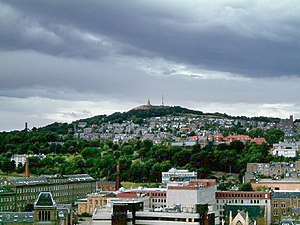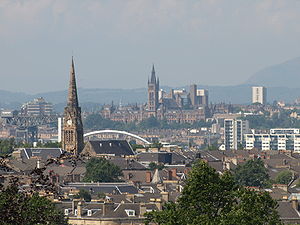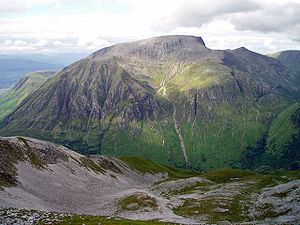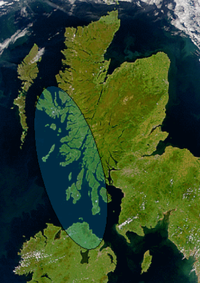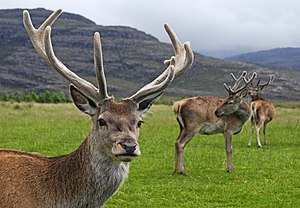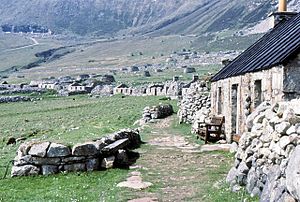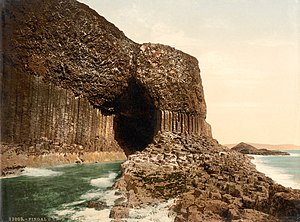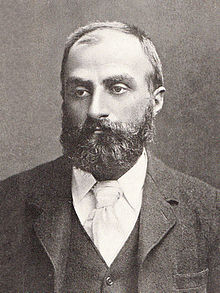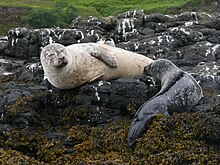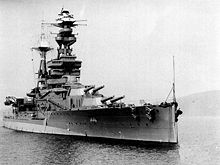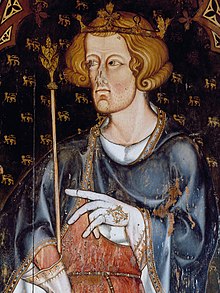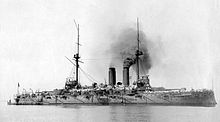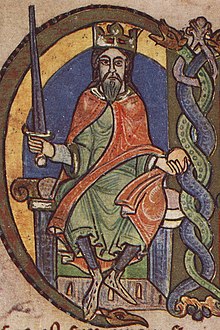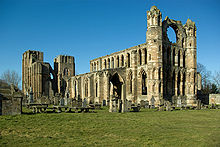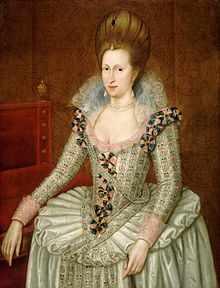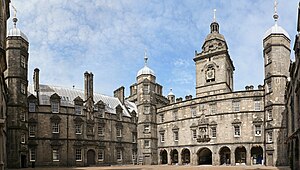User:Cactus.man/Sandbox/P-Sco/Selected articles
The Scotland Portal
| Main Page | Selected articles | Selected biographies | Selected quotes | Selected pictures | Featured Content | Categories & Topics |
Hand picked articles 1
Hand picked articles 2
Featured articles
Featured articles

The flora of Scotland is an assemblage of native plant species including over 1,600 vascular plants, more than 1,500 lichens and nearly 1,000 bryophytes. The total number of vascular species is low by world standards but lichens and bryophytes are abundant and the latter form a population of global importance. Various populations of rare fern exist, although the impact of 19th-century collectors threatened the existence of several species. The flora is generally typical of the north-west European part of the Palearctic realm and prominent features of the Scottish flora include boreal Caledonian forest (much reduced from its natural extent), heather moorland and coastal machair. In addition to the native species of vascular plants there are numerous non-native introductions, now believed to make up some 43% of the species in the country.
There are a variety of important trees species and specimens; a Grand Fir in Argyll is the tallest tree in the United Kingdom and the Fortingall Yew may be the oldest tree in Europe. The Arran Whitebeams, Shetland Mouse-ear and Scottish Primrose are endemic flowering plants and there are a variety of endemic mosses and lichens. Conservation of the natural environment is well developed and various organisations play an important role in the stewardship of the country's flora. Numerous references to the country's flora appear in folklore, song and poetry. (Full article...)
James McAvoy (/ˈmækəvɔɪ/; born 21 April 1979) is a Scottish actor. He made his acting debut as a teen in The Near Room (1995) and appeared mostly on television until 2003, when his feature film career began. His notable television work includes the thriller State of Play (2003), the science fiction miniseries Frank Herbert's Children of Dune (2003), and the drama series Shameless (2004–2005).
McAvoy gained recognition for playing Mr. Tumnus in the fantasy film The Chronicles of Narnia: The Lion, the Witch and the Wardrobe (2005) and an assassin in the action film Wanted (2008). His performances in the period dramas The Last King of Scotland (2006) and Atonement (2007) gained him nominations for the BAFTA Award. In 2011 he voiced the title characters in Arthur Christmas and Gnomeo & Juliet, reprising the latter role in Sherlock Gnomes, and portrayed Charles Xavier in the superhero film X-Men: First Class, a role he reprised in future installments of the X-Men series. McAvoy gained praise for starring in the independent crime film Filth (2013) and as a superpowered man with 23 dissociative identities in M. Night Shyamalan's Split (2016) and Glass (2019). He portrayed Lord Asriel in the fantasy series His Dark Materials from 2019 to 2022, and starred as Bill Denbrough in the horror film It Chapter Two (2019). (Full article...)
The Camus Cross, otherwise known as the Camuston or Camustane Cross, is an Early Medieval Scottish standing stone on the Panmure Estate near Carnoustie in Angus, Scotland. First recorded in the 15th century in a legal document describing the boundaries between Camuston and the barony of Downie, and described in the 17th century by Robert Maule, it is a freestanding cross, rare in Eastern Scotland.
The cross is thought to date from the 10th century, and exhibits distinctive Hiberno-Scottish mission influences, in common with several other monuments in the area. Tradition and folk etymology suggest that the cross marked the burial site of Camus, leader of the Norse army purportedly defeated by King Malcolm II at the apocryphal Battle of Barry. The name of the stone is likely to derive from the extinct village of Camuston, which has a Celtic toponymy. (Full article...)
German submarine U-27 was a Type VIIA U-boat of Nazi Germany's Kriegsmarine built for service in World War II. Her keel was laid down in November 1935 in Bremen. She was commissioned in August 1936 with Korvettenkapitän Hans Ibbeken in command. Ibbeken was relieved on 4 October 1937, by Johannes Franz, who commanded the boat until 6 June 1939 when Hans-Georg von Friedeburg assumed command for barely one month. He was relieved on 8 July again by Johannes Franz, who commanded the boat until her loss on 20 September 1939.
U-27 had a very short career, with only one war patrol and only two enemy ships sunk. Following the sinking of two British trawlers, Davara on 13 September and Rudyard Kipling on 16 September, U-27 was hunted down and sunk west of Lewis, Scotland, by depth charges from the British destroyers HMS Fortune, Faulknor and Forester. All 38 crewmen survived and were made prisoner for the remainder of the war. (Full article...)
Robert White (1688 – 1752) was an early American physician, military officer, pioneer, and planter in the Colony of Virginia.
White was born in Scotland, the son of John White, a physician practicing in Paisley, Renfrewshire. He studied medicine at the University of Edinburgh, and later served as a surgeon with the rank of captain in the Royal Navy of the Kingdom of Great Britain. He relocated to the Thirteen Colonies between 1720 and 1730, first to Delaware, then Pennsylvania, and finally as a "pioneer settler" in present-day Frederick County, Virginia between 1732 and 1735. White was one of two physicians practicing in Frederick County, and conducted his practice from his residence near Great North Mountain. White was part of a larger wave of Scottish physicians who settled in Virginia prior to the American Revolutionary War. (Full article...)
White was born in Scotland, the son of John White, a physician practicing in Paisley, Renfrewshire. He studied medicine at the University of Edinburgh, and later served as a surgeon with the rank of captain in the Royal Navy of the Kingdom of Great Britain. He relocated to the Thirteen Colonies between 1720 and 1730, first to Delaware, then Pennsylvania, and finally as a "pioneer settler" in present-day Frederick County, Virginia between 1732 and 1735. White was one of two physicians practicing in Frederick County, and conducted his practice from his residence near Great North Mountain. White was part of a larger wave of Scottish physicians who settled in Virginia prior to the American Revolutionary War. (Full article...)
East Kirkton Quarry, or simply East Kirkton, is a former limestone quarry in West Lothian, Scotland, now a renowned fossil site. The quarry is known for terrestrial and freshwater fossils about 335 million years old, from the late Viséan stage of the Mississippian subperiod (Early Carboniferous Period). The quarry is a 200-meter-long (~650 ft) depression located in the town of Bathgate. Geographically, it sits at the Bathgate Hills near the center of the Midland Valley, a fossil-rich region of southeast Scotland. The site is dominated by volcanic tuff, limestone, and silica deposits of large freshwater lakes associated with hot springs and local basaltic (high-iron) volcanism. Three geological intervals are exposed: the East Kirkton Limestone (oldest), Little Cliff Shale (middle), and Geikie Tuff (youngest).
The East Kirkton Limestone in particular has produced numerous well-preserved fossils of tetrapods (four-limbed vertebrates) and arthropods (multi-legged chitinous invertebrates like millipedes and arachnids). East Kirkton had been ignored by paleontologists since the 1840s, but Scottish fossil collector Stan Wood managed to procure the land in 1985, sparking a rush of scientific interest. New species from East Kirkton have been named on a regular basis since 1990, and nearly all of these species have been found nowhere else. Notable discoveries include Westlothiana (one of the most reptile-like Mississippian tetrapods), Balanerpeton (a common early representative of amphibians in the group Temnospondyli), and Pulmonoscorpius (the largest known terrestrial scorpion). The East Kirkton area represents an unconventional environment: dry woodlands and mineral-rich lakes nestled among volcanic cinder cones. Aquatic animals, though not uncommon, are less diverse than those found in the swampy coal forests and coastal sediments prevalent at other Scottish Carboniferous fossil sites. The prevalence of terrestrial organisms represents a broader trend of decreasing reliance on an amphibious lifestyle during the Carboniferous Period. (Full article...)
Urquhart Castle (/ˈɜːrkərt/ UR-kərt; Scottish Gaelic: Caisteal na Sròine) is a ruined castle that sits beside Loch Ness in the Highlands of Scotland. The castle is on the A82 road, 21 kilometres (13 mi) south-west of Inverness and 2 kilometres (1.2 mi) east of the village of Drumnadrochit.
The present ruins date from the 13th to the 16th centuries, though built on the site of an early medieval fortification. Founded in the 13th century, Urquhart played a role in the Wars of Scottish Independence in the 14th century. It was subsequently held as a royal castle and was raided on several occasions by the MacDonald Earls of Ross. The castle was granted to the Clan Grant in 1509, though conflict with the MacDonalds continued. Despite a series of further raids the castle was strengthened, only to be largely abandoned by the middle of the 17th century. Urquhart was partially destroyed in 1692 to prevent its use by Jacobite forces, and subsequently decayed. In the 20th century, it was placed in state care as a scheduled monument and opened to the public: it is now one of the most-visited castles in Scotland and received 547,518 visitors in 2019. (Full article...)

The Clydesdale is a Scottish breed of draught horse. It takes its name from Clydesdale, a region of Scotland centred on the River Clyde.
The origins of the breed lie in the seventeenth century, when Flemish stallions were imported to Scotland and mated with local mares; in the nineteenth century, Shire blood was introduced. The first recorded use of the name "Clydesdale" for the breed was in 1826; the horses spread through much of Scotland and into northern England. After the breed society was formed in 1877, thousands of Clydesdales were exported to many countries of the world, particularly to Australia and New Zealand. In the early twentieth century numbers began to fall, both because many were taken for use in the First World War, and because of the increasing mechanisation of agriculture. By the 1970s, the Rare Breeds Survival Trust considered the breed vulnerable to extinction. Numbers have since increased slightly. (Full article...)
Scotland in the Middle Ages concerns the history of Scotland from the departure of the Romans to the adoption of major aspects of the Renaissance in the early sixteenth century.
From the fifth century northern Britain was divided into a series of kingdoms. Of these the four most important to emerge were the Picts, the Gaels of Dál Riata, the Britons of Strathclyde and the Anglo-Saxon kingdom of Bernicia, later taken over by Northumbria. After the arrival of the Vikings in the late eighth century, Scandinavian rulers and colonies were established along parts of the coasts and in the islands. (Full article...)
From the fifth century northern Britain was divided into a series of kingdoms. Of these the four most important to emerge were the Picts, the Gaels of Dál Riata, the Britons of Strathclyde and the Anglo-Saxon kingdom of Bernicia, later taken over by Northumbria. After the arrival of the Vikings in the late eighth century, Scandinavian rulers and colonies were established along parts of the coasts and in the islands. (Full article...)
The Jocky Wilson Cup (officially the PartyPoker.com Jocky Wilson Cup for sponsorship) was a professional darts team tournament that took place at the Braehead Arena in Glasgow, Scotland, on 5 December 2009. This one-off tournament, which was named after Jocky Wilson, a two-time world darts champion, was the last of the eight non-ranking Professional Darts Corporation (PDC) events of the 2009 season. The tournament was contested by two nations of two players each. The winning nation was the first country to earn four points over a five-match series – four singles fixtures and one doubles game.
Phil Taylor and James Wade of England won the competition and whitewashed their opponents Gary Anderson and Robert Thornton of Scotland 6–0. Wade won the first game against Anderson 6–4; Taylor beat Thornton 6–0 in the second. Wade and Taylor defeated their opponents in the doubles match 6–2 for the overall victory and won their final two singles matches 6–4 over their Scottish opponents. (Full article...)
Phil Taylor and James Wade of England won the competition and whitewashed their opponents Gary Anderson and Robert Thornton of Scotland 6–0. Wade won the first game against Anderson 6–4; Taylor beat Thornton 6–0 in the second. Wade and Taylor defeated their opponents in the doubles match 6–2 for the overall victory and won their final two singles matches 6–4 over their Scottish opponents. (Full article...)
Château Gaillard (French pronunciation: [ʃɑto ɡajaʁ]) is a medieval castle ruin overlooking the River Seine above the commune of Les Andelys, in the French department of Eure, in Normandy. It is located some 95 kilometres (59 mi) north-west of Paris and 40 kilometres (25 mi) from Rouen. Construction began in 1196 under the auspices of Richard the Lionheart, who was simultaneously King of England and feudal Duke of Normandy. The castle was expensive to build, but the majority of the work was done in an unusually short period of time. It took just two years and, at the same time, the town of Petit Andely was constructed. Château Gaillard has a complex and advanced design, and uses early principles of concentric fortification; it was also one of the earliest European castles to use machicolations. The castle consists of three enclosures separated by dry moats, with a keep in the inner enclosure.
Château Gaillard was captured in 1204 by the king of France, Philip II, after a lengthy siege. In the mid-14th century, the castle was the residence of the exiled David II of Scotland. The castle changed hands several times in the Hundred Years' War, but in 1449 the French king captured Château Gaillard from the English king definitively, and from then on it remained in French ownership. Henry IV of France ordered the demolition of Château Gaillard in 1599; although it was in ruins at the time, it was felt to be a threat to the security of the local population. The castle ruins are listed as a monument historique by the French Ministry of Culture. The inner bailey is open to the public from March to November, and the outer baileys are open all year. (Full article...)
John Ogilby (also Ogelby, Oglivie; 17 November 1600 – 4 September 1676) was a Scottish translator, impresario, publisher and cartographer. He was probably at least a half-brother to James Ogilvy, 1st Earl of Airlie, though neither overtly acknowledged this. Ogilby's most-noted works include translations of the works of Virgil and Homer, and his version of the Fables of Aesop.
Ogilby established Ireland's first theatre in Werburgh Street, Dublin, and following the Restoration, that country's first Theatre Royal. Ogilby played a significant part in arrangements for the coronation of King Charles II. Following the Great Fire of 1666, Ogilby's large-scale map of the City of London was founded on precise survey work, and his Britannia is the first road atlas of England and Wales to be based on surveys and measurements, and drawn to scale. (Full article...)
Alexander Buchan (died 17 April 1769) was a Scottish landscape artist. He is known for his participation in the 1768–1771 first voyage of James Cook aboard HMS Endeavour, where he was one of the artists in the entourage of botanist Joseph Banks. Buchan had epilepsy. On the journey, he had two documented seizures, the first during an expedition in Tierra del Fuego. Buchan died after the second seizure, shortly after Endeavour's arrival at Tahiti, and was buried at sea. Buchan produced landscapes, coastal views, ethnographic drawings and natural history drawings. He is best known for illustrations of the people of Tierra del Fuego, some of which were engraved for publication in accounts of the voyage. All of his drawings from the voyage were taken by his employer Joseph Banks and are now in the British Library and the Natural History Museum, London. (Full article...)
The Labour Party of Scotland was a minor Scottish nationalist political party that was active in the early 1970s. Formed as a left-wing breakaway from Dundee's branch of the Scottish National Party (SNP), it is perhaps best known for standing in the Dundee East by-election of 1973, where its interference split the nationalist vote and probably cost the SNP a parliamentary seat as a result. The party contested elections to Dundee City Council two months later but was ultimately unsuccessful. It folded soon after, and by early 1974 most of its membership had returned to the SNP, whose campaigns on North Sea oil were proving popular with Scotland's urban electorate. It never had any official political representation.
William Wolfe, then leader of the SNP, dismissed the Labour Party of Scotland's founding as opportunism on the part of local politicians. These included George MacLean, the party's most popular member, whose by-election rival Gordon Wilson succeeded Wolfe in 1979. (Full article...)
William Wolfe, then leader of the SNP, dismissed the Labour Party of Scotland's founding as opportunism on the part of local politicians. These included George MacLean, the party's most popular member, whose by-election rival Gordon Wilson succeeded Wolfe in 1979. (Full article...)
Tibbers Castle is a motte-and-bailey castle overlooking a ford across the River Nith in Dumfries and Galloway, Scotland. To the east is the village of Carronbridge and to the north west is a 16th-century country house, Drumlanrig Castle.
Possibly built in the 12th or 13th century, Tibbers was first documented in 1298 at which point the timber castle was replaced by a stone castle. It was the administrative centre of the barony of Tibbers until the second half of the 14th century when it shifted to nearby Morton. During the Anglo-Scottish Wars of the early 14th century the castle was captured by first the Scots under Robert the Bruce and then the English, before returning to Scottish control in 1313. (Full article...)
James Ferguson FRSE (25 May 1735 – 6 September 1820) was a Scottish advocate and Tory politician and the third Laird of Pitfour, a large estate in the Buchan area of north east Scotland, which is known as the 'Blenheim of the North'.
Ferguson studied law in Edinburgh, qualifying in 1757 to gain membership of the Faculty of Advocates. He then undertook a tour of Europe throughout 1758 before following in his father's footsteps by joining the Scottish legal profession. Later in life his interests turned to politics and he became a Scottish Tory politician. (Full article...)

The Glenlivet distillery is a distillery near Ballindalloch in Moray, Scotland, that produces single malt Scotch whisky. It is the oldest legal distillery in the Highlands of Scotland. It was founded in 1824 and has operated almost continuously since.
The distillery remained open throughout the Great Depression and its only closure came during World War II. The Glenlivet distillery has grown in the post-war period to become one of the biggest single malt distilleries. The Glenlivet brand is the biggest selling single malt whisky in the United States and the second biggest selling single malt brand globally after Glenfiddich. (Full article...)

Maybole Castle is a 16th-century castle located on High Street in Maybole, South Ayrshire, Scotland. Originally built for the Earls of Cassillis, it is an L-shaped construction with Victorian two-storey extensions. It is associated with a legend of John Faa, in which an earl killed Faa and imprisoned his wife, the Countess of Cassilis, in the castle.
The castle became a Category A listed building in 1971. It was added to the Buildings at Risk Register for Scotland in 2009, before receiving funding in the early 21st century for renovations. (Full article...)

Isobel Gowdie was a Scottish woman who confessed to witchcraft at Auldearn near Nairn during 1662. Scant information is available about her age or life and, although she was probably executed in line with the usual practice, it is uncertain whether this was the case or if she was allowed to return to the obscurity of her former life as a cottar’s wife. Her detailed testimony, apparently achieved without the use of violent torture, provides one of the most comprehensive insights into European witchcraft folklore at the end of the era of witch-hunts.
The four confessions she made over a period of six weeks include details of charms and rhymes, claims she was a member of a coven in the service of the Devil and that she met with the fairy queen and king. Lurid information concerning carnal dealings with the Devil were also provided. A combination of demonic and fairy beliefs, the narratives were used by Margaret Murray as the basis for her now mostly discredited theories about cults and witchcraft. (Full article...)

![Image 1 The Dundee Law Dundee (/dʌnˈdiː/ ⓘ; Scots: Dundee; Scottish Gaelic: Dùn Dè or Dùn Dèagh, pronounced [t̪un ˈtʲeː]) is the fourth-largest city in Scotland. The mid-year population estimate for 2016 was 148,210, giving Dundee a population density of 2,478/km2 or 6,420/sq mi, the second-highest in Scotland. It lies within the eastern central Lowlands on the north bank of the Firth of Tay, which feeds into the North Sea. Under the name of Dundee City, it forms one of the 32 council areas used for local government in Scotland. Within the boundaries of the historic county of Angus, the city developed into a burgh in the late 12th century and established itself as an important east coast trading port. Rapid expansion was brought on by the Industrial Revolution, particularly in the 19th century when Dundee was the centre of the global jute industry. This, along with its other major industries, gave Dundee its epithet as the city of "jute, jam and journalism". Today, Dundee is promoted as "One City, Many Discoveries" in honour of Dundee's history of scientific activities and of the RRS Discovery, Robert Falcon Scott's Antarctic exploration vessel, which was built in Dundee and is now berthed at Discovery Point. Biomedical and technological industries have arrived since the 1980s, and the city now accounts for 10% of the United Kingdom's digital entertainment industry, including mobile app development and gaming. Dundee has two universities – the University of Dundee and Abertay University. In 2014, Dundee was recognised by the United Nations as the UK's first UNESCO City of Design for its diverse contributions to fields including medical research, comics and video games. (Full article...) Read more ... (Full article...)](http://upload.wikimedia.org/wikipedia/en/d/d2/Blank.png)
